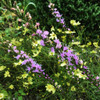
Liatris microcephala - DWARF BLAZING STAR
Cute and delicate looking Liatris with very fine needle-like leaves and small rose-pink flowers. Best in drier, somewhat drained and leaner soils.
Only 1.5-2' and 1' wide.
Flowers from the top to the bottom for about 3-4 weeks in August and September.
Full sun, half sun, drained, rocky, sandy soils, average soils with some drainage. Medium moist (average) to dry. Adaptable to many soil types, if some drainage is provided. In too rich or too moist soil may flop.
Very drought tolerant, tough, heat and humidity tolerant.
Suitable for zones 4-8. Deer resistant. Flowers attract hummingbirds and pollinators, seedheads attract small birds.
Native to south eastern USA and southern Appalachia region, where can be found in dry sandy prairies, rock outcrops, open woodlands, rocky slopes, sunny glades, sandy stream banks, openings in pine-oak/oak barrens. Prefers slightly acidic soil (but seems to be fairly adaptable in garden conditions). See the BONAP distribution map
Best in sunny and drier beds, rock gardens, xeriscape, slopes, big containers, in combinations with rocks, roof gardens, in extreme hot and heat conditions and on lean soils.
Can be combined with shorter and more subtle drought tolerant perennials and grasses like Antennaria, Amorpha nana, Anaphallis margaritacea, Baptisia (shorter cultivars), Callirhoe, Campanula rotundifolia, Coreopsis, Dalea, narrow-leaved Echinacea and shorter cultivars, Eriogonum, Eryngium yuccifolium, Oenothera, Ruellia humilis, Rudbeckia hirta, R. missouriensis,Verbena stricta and grasses like Andropogon, Boutelloua, Koeleria, Schizachyrium or Sporobolus.
From the non-native perennials choose Artemisia, Calamintha, Eryngium, Nepeta x faasenii – shorter cultivars, smaller Perovskia cultivars or Salvia nemorosa.
Other common names are Small Headed Gayfeather.
Pot size : square 3.5" x 4" deep perennial pot
Picture copyright :1 - Paul Bouseman, 2 - David J Stang, Commons Wikipedia

Liatris microcephala - DWARF BLAZING STAR
Cute and delicate looking Liatris with very fine needle-like leaves and small rose-pink flowers. Best in drier, somewhat drained and leaner soils.
Only 1.5-2' and 1' wide.
Flowers from the top to the bottom for about 3-4 weeks in August and September.
Full sun, half sun, drained, rocky, sandy soils, average soils with some drainage. Medium moist (average) to dry. Adaptable to many soil types, if some drainage is provided. In too rich or too moist soil may flop.
Very drought tolerant, tough, heat and humidity tolerant.
Suitable for zones 4-8. Deer resistant. Flowers attract hummingbirds and pollinators, seedheads attract small birds.
Native to south eastern USA and southern Appalachia region, where can be found in dry sandy prairies, rock outcrops, open woodlands, rocky slopes, sunny glades, sandy stream banks, openings in pine-oak/oak barrens. Prefers slightly acidic soil (but seems to be fairly adaptable in garden conditions). See the BONAP distribution map
Best in sunny and drier beds, rock gardens, xeriscape, slopes, big containers, in combinations with rocks, roof gardens, in extreme hot and heat conditions and on lean soils.
Can be combined with shorter and more subtle drought tolerant perennials and grasses like Antennaria, Amorpha nana, Anaphallis margaritacea, Baptisia (shorter cultivars), Callirhoe, Campanula rotundifolia, Coreopsis, Dalea, narrow-leaved Echinacea and shorter cultivars, Eriogonum, Eryngium yuccifolium, Oenothera, Ruellia humilis, Rudbeckia hirta, R. missouriensis,Verbena stricta and grasses like Andropogon, Boutelloua, Koeleria, Schizachyrium or Sporobolus.
From the non-native perennials choose Artemisia, Calamintha, Eryngium, Nepeta x faasenii – shorter cultivars, smaller Perovskia cultivars or Salvia nemorosa.
Other common names are Small Headed Gayfeather.
Pot size : square 3.5" x 4" deep perennial pot
Picture copyright :1 - Paul Bouseman, 2 - David J Stang, Commons Wikipedia









